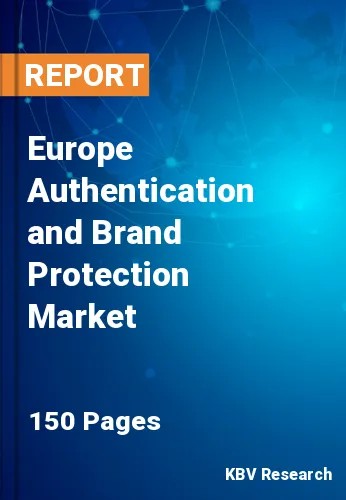The Europe Authentication and Brand Protection Market would witness market growth of 7.8% CAGR during the forecast period (2023-2030).
Many businesses have invested in supply chain and inventory management systems to gather information and improve manufacturing and inventory management. However, this method frequently fails to incorporate brand security. Because of this, a lot of brand owners employ specialized physical security measures like holograms, licensing keys, and UV inks to manually identify issues in the post-manufacturing distribution channels. Additionally, as data collection technology advances and becomes more widely accessible to consumers via the ubiquitous smartphone, more brands may be able to integrate reciprocal interaction with customers through smartphones and products to start the amazing scope of data collection toward the point of sale.
Artificial intelligence (AI), though still in its infancy as a technology, is already being used in several aspects of brand protection. Computers, for example, may examine and learn from huge, complicated datasets using machine learning, spotting trends that could indicate fraud or diversion. Along with data gathered from sensors, packaging can be examined.
According to the Centre for the Promotion of Imports (CBI), several large and well-known garment companies in Europe have a robust apparel demand. The European imported clothing sector was worth €144.5 billion in 2021. Germany, France, Spain, the Netherlands, Italy, and Poland are some of the major markets in Europe. Together, these nations account for 67% of all imports into the EU as well as roughly 73% of all garment imports from other countries. The top exporters from the EU in 2021 were Germany ($18.2 billion), Poland ($9.5 billion), Spain ($8.3 billion), Italy ($8.2 billion), the Netherlands ($7.9 billion), France ($4.9 billion), and Belgium ($4.5 billion). This has increased the probabilities of fraud and counterfeit goods in the region.
Many countries have also reported increased production of pirated and counterfeit goods, which have detrimental effects on the regional businesses. According to the OECD data, the most accurate projections show that UK imports of fake and pirated goods reached GBP 13.6 billion in 2016, equal to 3% of the country's imports of legitimate goods. Thus, the region presents lucrative growth prospects for the growth of the market.
The Germany market dominated the Europe Authentication and Brand Protection Market by Country in 2022, and would continue to be a dominant market till 2030; thereby, achieving a market value of $336.1 million by 2030. The UK market is exhibiting a CAGR of 6.8% during (2023 - 2030). Additionally, The France market would experience a CAGR of 8.5% during (2023 - 2030).
Based on Offering, the market is segmented into Barcodes & QR Codes, Security Labels & Inks, RFID/NFC, Holograms and Authentication Chips. Based on Application, the market is segmented into Pharmaceuticals, Food & Beverages, Electronics, Automobile, Apparel, Luxury Goods, Cosmetics and Others. Based on Technology, the market is segmented into Overt, Covert, Digital and Forensic. Based on Authentication Mode, the market is segmented into Blockchain and Smartphone. Based on countries, the market is segmented into Germany, UK, France, Russia, Spain, Italy, and Rest of Europe.
Free Valuable Insights: The Worldwide Authentication and Brand Protection Market is Projected to reach USD 5.1 Billion by 2030, at a CAGR of 8.2%
The market research report covers the analysis of key stake holders of the market. Key companies profiled in the report include Authentix Inc., Avery Dennison Corporatio, Brady Corporation, De La Reu plc, WISeKey International Holding Ltd, Infineon Technologies AG, Merck KGaA, Assa Abloy AB, Centro Grafico DG and Optel Group.
By Offering
By Application
By Technology
By Authentication Mode
By Country
Our team of dedicated experts can provide you with attractive expansion opportunities for your business.

